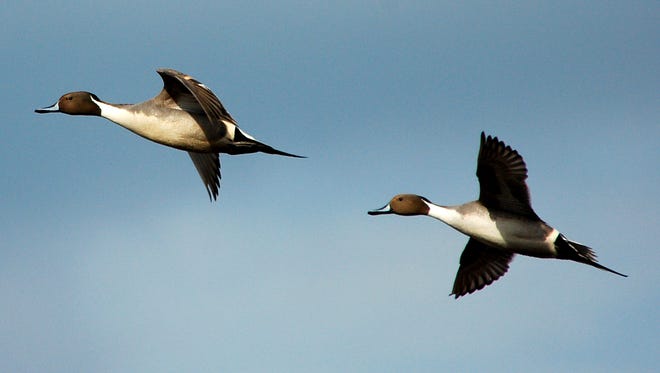Early signs are good for duck season

Diehard waterfowl hunters know that the seasons don't truly begin here on Delmarva in the fall, they begin in the northern prairie potholes and lakes of the boreal forests in late spring. That's when the ducks go north to nest for the year and what they find, as well as how they respond, are the keys to how many birds fly south to us in the fall and how good or bad our season may be.
Researchers track the ducks and their efforts in great detail each year and this year the news so far is good.
The annual breeding survey conducted by the U.S. Fish & Wildlife service and the Canadian Wildlife Service shows a total of 47.3 million breeding ducks this year, slightly lower than last year but still the fifth highest on record and 34 percent above the long-term average.
"The surveys indicate that wetland conditions and populations of most frequently harvested ducks remain above the long-term average, and for most species, populations were at or above those from last year," said Ducks Unlimited Chief Scientist Tom Moorman. "This is great news for waterfowlers who can now turn their attention to preparing habitat, tuning up dogs and relentlessly watching the weather forecasts for the onset of fall and winter weather that will push the birds on their annual southward migration."
MORE CIEKOT:Sure, it's early, but you can start preparing for goose season
Numbers to watch in the total are the ones that indicate what each species is doing, population-wise. Pintails, for example — a duck with a troubled recent history — showed a 10 percent increase over last year, although they are still 27 percent below their long-term average. Scaup, another duck of concern, showed a 12 percent decline from last year and are down 13 percent from their long term average. Canvasbacks, an important duck in the Chesapeake area, remain stable with numbers nearly identical to last year.
Some birds showed big increases. Gadwalls were at their highest ever, up 13 percent from last year and up 111 percent over their long-term average. Blue wing teal were up 18 percent over last year and up 57 percent from their long-term average. Shovelers were up 10 percent from 2016 and up 69 percent over the long term.
Much of the increase can be attributed to favorable habitat conditions in the nesting areas. The Spring Pond Count on the prairies, for example, was over 6 million this year, up 22 percent from last year. Yet both the breeding numbers and the pond counts are only what is on the nesting grounds, not what we'll see for fall flight numbers.
"I think the pond count is a little misleading, because wetlands in the Dakotas and parts of the southern Canadian prairies dried out quickly and dramatically following the surveys," said Dr. Frank Rohwer, president of Delta Waterfowl. "Renesting and brood survival are going to be far lower this year. I don't expect the production we've seen in recent years. We will see a lot of birds flying south, but it'll be more challenging for hunters because the flight will have a higher percentage of adult ducks."
Regardless of what the final numbers turn out to be, the seasons are set and all we can do is wait. Cross your fingers for cold weather and plenty of birds this fall.
MORE CIEKOT:How to keep your tree stand from killing you
Outdoor Calendar
Aug. 17-19: 24th annual Capt. Steve Harman Poor Girl's Open, Bahia Marina, Ocean City, 410-289-7473
Aug. 18-20: 2017 Flounder Pounder Open, Long Neck, Delaware, flounderpounderopen.com
Aug. 20-25: 26th annual Mid-Atlantic Tuna Tournament, Sunset Marina, Ocean City, 410-213-9600
Aug. 24-27: OC Jeep Week 2017; show, beach crawl and Jeep Jam with mud pits and obstacle course, show at OC Convention Center, oceancityjeepweek.com for full details
Sept. 1-3: 59th annual Labor Day White Marlin Tournament, OC Marlin Club, Ocean City, 410-213-1613
Sept. 1-25: Virginia early Canada goose season, 10 daily
Sept. 1-25: Delaware early resident Canada goose season, 15 daily
Sept. 1-15: Maryland early resident Canada goose season, eight daily
Sept. 1-Jan. 31: Delaware archery and crossbow deer seasons
Sept. 1-30: First segment of Delaware mourning dove season
Sept. 2-Oct. 29: First segment of Virginia mourning dove season, shooting hours begin at noon through Sept. 8
Sept. 2-Feb. 28: Virginia squirrel season
Sept. 2-Feb. 28: Maryland squirrel season
Sept. 8-26: Delaware early teal season, six daily
Sept. 8: Opening day of Maryland archery deer season
Sept. 9-Nov. 17: State of Virginia rail season
Sept. 15-Feb. 3: Delaware squirrel season
Sept. 16-20: Virginia eastern zone teal season, six daily
Sept. 16-30: Maryland early teal season, six daily
Through Dec. 20: Chesapeake striped bass season, main Bay and all tributaries, two fish daily, 20 inches minimum, only one over 28 inches